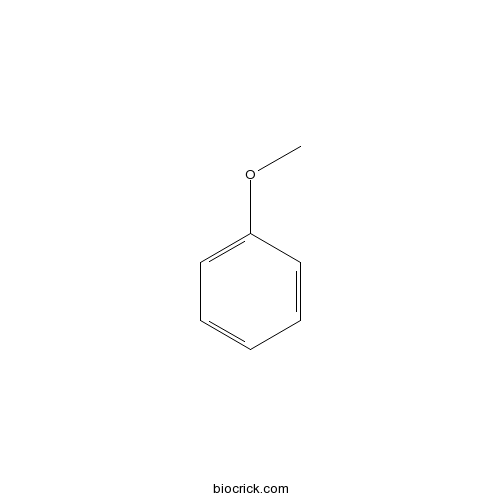AnisoleCAS# 100-66-3 |

Quality Control & MSDS
3D structure
Package In Stock
Number of papers citing our products

| Cas No. | 100-66-3 | SDF | Download SDF |
| PubChem ID | 7519 | Appearance | Powder |
| Formula | C7H8O | M.Wt | 108.13 |
| Type of Compound | Phenols | Storage | Desiccate at -20°C |
| Solubility | Soluble in Chloroform,Dichloromethane,Ethyl Acetate,DMSO,Acetone,etc. | ||
| Chemical Name | anisole | ||
| SMILES | COC1=CC=CC=C1 | ||
| Standard InChIKey | RDOXTESZEPMUJZ-UHFFFAOYSA-N | ||
| General tips | For obtaining a higher solubility , please warm the tube at 37 ℃ and shake it in the ultrasonic bath for a while.Stock solution can be stored below -20℃ for several months. We recommend that you prepare and use the solution on the same day. However, if the test schedule requires, the stock solutions can be prepared in advance, and the stock solution must be sealed and stored below -20℃. In general, the stock solution can be kept for several months. Before use, we recommend that you leave the vial at room temperature for at least an hour before opening it. |
||
| About Packaging | 1. The packaging of the product may be reversed during transportation, cause the high purity compounds to adhere to the neck or cap of the vial.Take the vail out of its packaging and shake gently until the compounds fall to the bottom of the vial. 2. For liquid products, please centrifuge at 500xg to gather the liquid to the bottom of the vial. 3. Try to avoid loss or contamination during the experiment. |
||
| Shipping Condition | Packaging according to customer requirements(5mg, 10mg, 20mg and more). Ship via FedEx, DHL, UPS, EMS or other couriers with RT, or blue ice upon request. | ||
| Description | Anisole is a flavouring agent that is a precursor to perfumes, insect pheromones, and pharmaceuticals. It is also a new dopant for atmospheric pressure photoionization mass spectrometry of low proton affinity, low ionization energy compounds. |
| Structure Identification | Applied Catalysis Volume 49, Issue 1, 3 April 1989, Pages 109–123Design of synthetic zeolites as catalysts in organic reactions: Acylation of Anisole by Acyl Chlorides or Carboxylic Acids Over Acid Zeolites[Reference: WebLink]
Rapid Commun Mass Spectrom. 2004;18(7):808-15.Anisole, a new dopant for atmospheric pressure photoionization mass spectrometry of low proton affinity, low ionization energy compounds.[Pubmed: 15052564 ]Atmospheric pressure photoionization (APPI) is a novel method of ionization in liquid chromatography/mass spectrometry (LC/MS). |

Anisole Dilution Calculator

Anisole Molarity Calculator
| 1 mg | 5 mg | 10 mg | 20 mg | 25 mg | |
| 1 mM | 9.2481 mL | 46.2406 mL | 92.4813 mL | 184.9625 mL | 231.2032 mL |
| 5 mM | 1.8496 mL | 9.2481 mL | 18.4963 mL | 36.9925 mL | 46.2406 mL |
| 10 mM | 0.9248 mL | 4.6241 mL | 9.2481 mL | 18.4963 mL | 23.1203 mL |
| 50 mM | 0.185 mL | 0.9248 mL | 1.8496 mL | 3.6993 mL | 4.6241 mL |
| 100 mM | 0.0925 mL | 0.4624 mL | 0.9248 mL | 1.8496 mL | 2.312 mL |
| * Note: If you are in the process of experiment, it's necessary to make the dilution ratios of the samples. The dilution data above is only for reference. Normally, it's can get a better solubility within lower of Concentrations. | |||||

Calcutta University

University of Minnesota

University of Maryland School of Medicine

University of Illinois at Chicago

The Ohio State University

University of Zurich

Harvard University

Colorado State University

Auburn University

Yale University

Worcester Polytechnic Institute

Washington State University

Stanford University

University of Leipzig

Universidade da Beira Interior

The Institute of Cancer Research

Heidelberg University

University of Amsterdam

University of Auckland

TsingHua University

The University of Michigan

Miami University

DRURY University

Jilin University

Fudan University

Wuhan University

Sun Yat-sen University

Universite de Paris

Deemed University

Auckland University

The University of Tokyo

Korea University
- Benzaldehyde
Catalog No.:BCN8529
CAS No.:100-52-7
- Benzylamine
Catalog No.:BCN1789
CAS No.:100-46-9
- Pentamidine
Catalog No.:BCC3836
CAS No.:100-33-4
- 4-Methoxybenzoic acid
Catalog No.:BCN3838
CAS No.:100-09-4
- Dauriporphinoline
Catalog No.:BCN7901
CAS No.:100009-82-3
- 2-Methylthioadenosine triphosphate tetrasodium salt
Catalog No.:BCC6918
CAS No.:100020-57-3
- A-867744
Catalog No.:BCC1324
CAS No.:1000279-69-5
- GIP (human)
Catalog No.:BCC5870
CAS No.:100040-31-1
- TAK-875
Catalog No.:BCC3702
CAS No.:1000413-72-8
- 8-Hydroxy-3,5,6,7,3',4'-hexamethoxyflavone
Catalog No.:BCN7870
CAS No.:1000415-56-4
- AS 19
Catalog No.:BCC7218
CAS No.:1000578-26-6
- KW 2449
Catalog No.:BCC2179
CAS No.:1000669-72-6
- Stilbostemin N
Catalog No.:BCN4741
CAS No.:1000676-45-8
- Tegobuvir
Catalog No.:BCC1991
CAS No.:1000787-75-6
- 7-Hydroxy-2',5,8-trimethoxyflavanone
Catalog No.:BCN5817
CAS No.:100079-34-3
- 2',4'-Dihydroxy-2,3',6'-trimethoxychalcone
Catalog No.:BCN1643
CAS No.:100079-39-8
Anisole, a new dopant for atmospheric pressure photoionization mass spectrometry of low proton affinity, low ionization energy compounds.[Pubmed:15052564]
Rapid Commun Mass Spectrom. 2004;18(7):808-15.
Atmospheric pressure photoionization (APPI) is a novel method of ionization in liquid chromatography/mass spectrometry (LC/MS). It was originally developed in order to broaden the range of LC/MS ionizable compounds towards less polar compounds that cannot be analyzed by electrospray (ESI) and atmospheric pressure chemical ionization (APCI). Studies done thus far have shown that non-polar compounds that earlier were not ionizable in LC/MS can indeed be ionized by the use of APPI. However, the best ionization efficiency for low polarity samples has been achieved with low proton affinity (PA) solvents that are not suitable in reversed-phase LC (RP-LC). Here it is demonstrated that the signals for analytes with low proton affinities in acetonitrile can be increased 100-fold by using Anisole as the dopant for APPI, which takes the sensitivity to the same level achieved in the analysis of high PA analytes.


